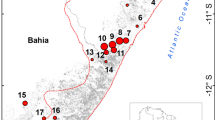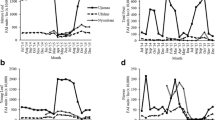Abstract
Annual surveys in 1985–1987 revealed that, since 1975, the total population of the Tana River red colobus (Colobus badius rufomitratus)declined by approximately 80%. An intensive study in 1986–1988 of two groups of colobus in the Tana River Primate National Reserve indicated that habitat disturbance from the changing river course and shifting agricultural practices were primarily responsible for the decline. Clearcutting around Mchelelo forest in the late 1960s compressed colobus populations to levels probably above the carrying capacity. Between 1975 and 1986 primate population density declined dramatically, the number of red colobus groups in Mchelelo forest decreased by half, and the size of the remaining group was greatly reduced. In 1986, there were fewer solitary colobus and small parties in the forest, harem male takeovers did not occur, infant survivorship increased, and demographic parameters generally had improved. The colobus groups in Mchelelo in 1973–1975, living at higher densities, showed different feeding and ranging behaviors than 1986–1988 groups. Range size was smaller in 1975, range overlap occurred, and a greater portion of the forest was used per day and per month. Mature leaves accounted for a much higher proportion of the diet. Time spent feeding and resting was the same in both studies. Social organization in predominantly one- male groups was maintained and adult and subadult females transferred between groups.
Similar content being viewed by others
References
Altmann, J. (1974). Observational study of behavior: Sampling methods.Behavior 49: 227–267.
Altmann, J., Hausfater, G., and Altmann, S. A. (1985). Demography of Amboseli baboons 1963–1983.Am. J. Primatol. 8: 113–125.
Baranga, D. (1982). Nutrient composition and food preferences of colobus monkeys in Kibale Forest, Uganda.Afr. J. Ecol. 20: 113–121.
Bormann, F. H., and Likens, G. E. (1979).Pattern and Process in a Forested Ecosystem, Springer-Verlag, New York.
Clutton-Brock, T. H., and Harvey, P. H. (1977). Species differences in feeding and ranging behavior in primates. In Clutton-Brock, T. H. (ed.),Primate Ecology, Academic Press, London, pp. 557–584.
Decker, B. S. (1989).Effects of Habitat Disturbance on the Behavioral Ecology and Demographics of the Tana River Red Colobus (Colobus badius rufomitratus), Ph.D. dissertation, Emory University, Atlanta, GA.
Decker, B. S. (1991a). Population viability of the Tana River red colobus. In Seal, O. S.et al. (eds.),Tana River Primate Reserve Conservation Assessment Workshop Report, CBSG/SSC/IUCN publication for Kenya Wildlife Service and The World Bank.
Decker, B. S. (1991b). Wildlife Sector of the Environmental Monitoring Unit Report to Nippon Koei/Tana-Athi River Development Authority, Kenya, Nov.
Decker, B. S., and Kinnaird, M. F. (1992). Tana River red colobus and crested mangabey: Results of recent censuses.Am. J. Primatol. 26: 47–52.
Dunbar, R. I. M. and Dunbar, E. P. (1974). Ecology and population dynamics ofColobus guereza in Ethiopia.Folia Primatol. 21: 188–208.
Forman, R. T. T., and Godron, M. (1986).Landscape Ecology, John Wiley and Sons, New York.
Grieg-Smith, P. (1957).Quantitative Plant Ecology, Butterworth, London.
Harris, L. D. (1984).The Fragmented Forest: Island Biogeography Theory and the Preservation of Biotic Diversity, University of Chicago Press, Chicago.
Hughes, F. M. R. (1984).The Tana River Floodplain Forest Kenya: Ecology and the Impact of Development, Ph.D. dissertation University of Cambridge, Girton College, Cambridge.
Lee, P. C., Thornback J., and Bennett, E. (1988).Threatened Primate of Africa, IUCN Red Data Book, IUCN, Cambridge, UK.
McKey, D. B., Gartlan, J. S., Waterman, P. G., and Choo, C. (1981). Food selection by black colobus monkeys(Colobus satanas) in relation to plant chemistry.Biol. J. Linn. Soc. Lond. 16: 115–146.
McNemar, Q. (1962).Psychological Statistics, 3rd ed., John Wiley Sons, New York.
Marsh, C. W. (1976). A management plan for the Tana River Came Reserve. Report to the Kenya Department of Wildlife Conservation and Management, Nairobi.
Marsh, C. W. (1978a).Ecology and Social Organization of the Tana River Red Colobus (Colobus badius rufomitratus). Ph.D. dissertation, University of Bristol, Bristol.
Marsh, C. W. (1978b). Tree phenology in a gallery forest on the Tana River, Kenya.E. Afr. Agr. For. J. 43(4): 305–316.
Marsh, C. W. (1979). Female transference and mate choice among Tana River red colobus.Nature 281: 568–569.
Marsh, C. W. (1981a). Ranging behavior and its relation to diet selection in Tana River red colobus(Colobus badius rufomitratus).J. Zool. (Lond). 195: 473–492.
Marsh, C. W. (1981b). Time budget of Tana River red colobus.Folia Primatol. 35: 30–50.
Marsh, C. W. (1981c). Diet choice among red colobus(Colobus badius rufomitratus) on the Tana River, Kenya.Folia Primatol. 35: 147–178.
Marsh, C. W. (1985).A Resurvey of Tana River Primates, Report to IPR and WCMD, Kenya, New York Zoological Society.
Marsh, C. W., and Homewood, K. (1974). Land use problems on the lower Tana River, with particular reference to the conservation of the Tana River red colobus and crested mangabey: A preliminary report and proposal. Unpublished report to Kenya government.
Marsh, C. W., Johns, A. D., and Ayres, J. M. (1987). Effects of habitat disturbance on rain forest primates. In Marsh, C. W., and Mittermeier, R. A. (eds.),Primate Conservation in the Tropical Rain Forest, Alan R. Liss, New York, pp. 83–107.
Medley, K. E. (1990).Forest Ecology and Conservation in the Tana River National Primate Reserve, Kenya. Ph.D. dissertation, Michigan State University, East Lansing.
Medley, K. E. (1992). Patterns of forest diversity along the Tana River, Kenya.J. Trop. Ecol. 8: 353–371.
Medley, K. E. (1993). Primate conservation along the Tana River, Kenya: An examination of the forest habitat.Cons. Biol. 7: 109–121.
Oates, J. F. (1977). The guereza and its food. In Clutton-Brock, T. H. (ed.),Primate Ecology, Academic Press, London, pp. 275–321.
Oates, J. F., Gartlan, J. S., and Struhsaker, T. T. (1987). A framework for African rain forest primate conservation. In Marsh, C. W., and Mittermeier, R. A. (eds.),Primate Conservation in the Tropical Rain Forest, Alan R. Liss, New York, pp. 321–327.
Ochiago, O. (1990). The Tana River red colobus(Colobus badius rufomitratus).Utafiti 3(1): 1–5.
Rudran, R. (1973). Adult male replacement in one-male troops of purple-faced langurs(Presbytis senex senex) and its effect on population structure.Folia Primatol. 19: 166–192.
Salo, J., Kalliola, R., Hakkinen, I., Makinen, Y., Niemela, P., Puhakka, M., and Coley, P. D. (1986). River dynamics and the diversity of Amazon lowland forest.Nature 322: 254–258.
Struhsaker, T. T. (1973). A recensus of vervet monkeys in the Masai-Amboseli Game Reserve, Kenya.Ecology 54: 930–932.
Struhsaker, T. T. (1975).The Red Colobus Monkey, University of Chicago Press, Chicago.
Struhsaker, T. F. (1981). Forest and primate conservation in East Africa.Afr. J. Ecol. 19: 99–114.
Struhsaker, T. T., and Leland, L. (1985). Infanticide in a patrilineal society of red colobus monkeys.Z. Tierpsychol. 69: 89–132.
Struhsaker, T. T., and Leland, L. (1987). Colobines: Infanticide by adult males. In Smuts, B. B., Cheney, D. L., Seyfarth, R. M., Wrangham, R. W., and Struhsaker, T. T. (eds.),Primate Societies, University of Chicago Press, Chicago, pp. 83–97.
Struhsaker, T. T., and Oates, J. F. (1975). Comparison of the behavior and ecology of red colobus and black and white colobus monkeys in Uganda: A summary. In Tuttle, R. H. (ed.),Socioecology and Psychology of Primates, Mouton, The Hague, pp. 103–123.
Struhsaker, T. T., and Pope, T. R. (1991). Mating system and reproductive success: A comparison of two African forest monkeys(Colobus badius andCercopithecus ascanius).Behavior 117(3–4): 182–205.
Terborgh, J. (1983).Five New World Primates: A Study in Comparative Ecology. Princeton University Press, Princeton.
Waterman, P. G. (1984). Food acquisition and processing as a function of plant chemistry. In Chivers, D. J., Wood, B. A., and Bilsborough, A. (eds.),Food Acquisition and Processing in Primates, Plenum Press, New York, pp. 177–211.
Waterman, P. G., and Choo, G. M. (1981). The effects of digestibility-reducing compounds in leaves on food selection by some colobinae.Malays. AppL Biol. 10(2): 147–162.
Wilcox, B. A. (1980). Insular ecology and conservation. In Soule, M. E., and Wilcox, B. A. (eds.),Conservation Biology: An Evolutionary-Ecological Perspective, Sinauer Associates, Sunderland, MA, pp. 95–117.
Yoshiba, K. (1968). Local and intertroop variability in ecology and social behavior of common Indian langurs. In Jay, P. C. (ed.),Primates: Studies in Adaptation Variability, Holt, Rinehart, and Winston, New York, pp. 217–242.
Author information
Authors and Affiliations
Rights and permissions
About this article
Cite this article
Decker, B.S. Effects of habitat disturbance on the behavioral ecology and demographics of the Tana river red colobus (Colobus badius rufomitratus). International Journal of Primatology 15, 703–737 (1994). https://doi.org/10.1007/BF02737428
Received:
Accepted:
Published:
Issue Date:
DOI: https://doi.org/10.1007/BF02737428




